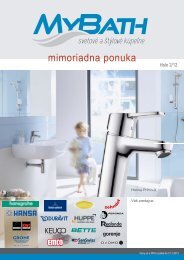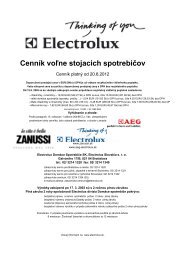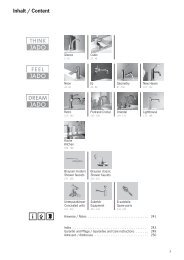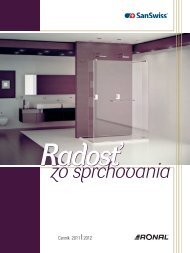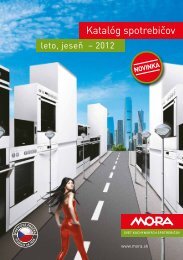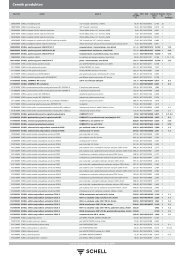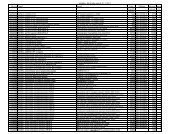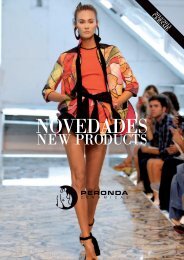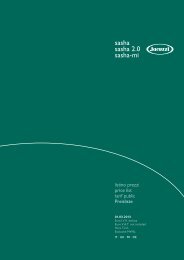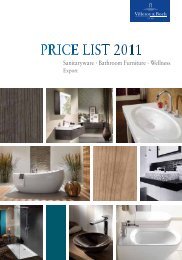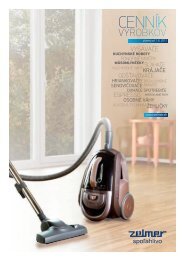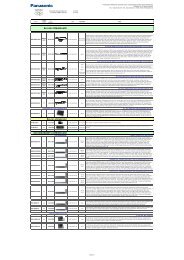EURO Pricelist 2011-12 - DOMOSS VO Shop
EURO Pricelist 2011-12 - DOMOSS VO Shop
EURO Pricelist 2011-12 - DOMOSS VO Shop
You also want an ePaper? Increase the reach of your titles
YUMPU automatically turns print PDFs into web optimized ePapers that Google loves.
Specialized terms from A–Z<br />
A<br />
ABS thick edges - (ABS = Acrylonitrile Butadiene Styrene)<br />
- ABS thick edges are 1, 2 or 4 mm thick. By applying<br />
these thick edges, rounding of the edges with radii from<br />
2-4 mm can be achieved<br />
C<br />
Ceramics - are industrially produced of high-quality porcelain<br />
row materials: kaolin, clay feldspart and quartz. When<br />
firing temperatures reach approximately 1,250°C, the ceramic<br />
body creates a lasting compound with the glaze that gives<br />
the product a high mechanical consistency and a cohesive<br />
glass surface.<br />
„Clou“ - The drainage and overflow system by Geberit<br />
without a visible overflow opening is supplied with the<br />
mineral cast washbasins with vantiy tops. A plastic tube<br />
divided in two parallel chambers is hidden behind the<br />
washbasin, directly under the top edge of the possible<br />
water level. If the maximum water level in the washbasin<br />
is reached, the overflowing water drains out through the<br />
two tube chamber.<br />
H<br />
HPL panels - (high pressure laminate panels) The HPL<br />
panel is often referred to as Resopal ® ; is made of a phenolic<br />
resin core with a thickness of 0.6 to 1 mm. This core is treated<br />
with a one - two melamine resin laminate panels. Adding<br />
another overlay increases the maximum abrasion resistance for<br />
this panel. HPL is mainly used for cover plates and vanity units,<br />
but also for high-quality fronts.<br />
M<br />
M Seal of Quality - The burgbad bathroom furniture has<br />
been awarded with the seal of quality by Möbel e.V.<br />
(Registered Association of Furniture Manufacturers). The<br />
Gütegemeinschaft Möbel is a federation of furniture<br />
manufacturers and suppliers whose products are tested<br />
by an independent testing facility, the Landesgewerbeanstalt<br />
(State Trade Agency).<br />
MDF - (medium density fiberboard) - The medium density<br />
fiberboard (MDF) is made of wood fiber that are produced<br />
in a mechanical and chemical manner. The particularly fine<br />
surface of the MDF is perfect for secondary processing.<br />
The edges can be contoured and lacquered.<br />
Melamine edging - Melamine edging is approx. 0.4 mm<br />
thick and is produced with the same colour and structure<br />
as the surface. The melamine edging is fixed to the edge<br />
of the particle board with PUR hot melt adhesive and<br />
milled level to flush.<br />
Melamine panels - Melamine panels are particle boards<br />
that are treated with a melamine paper (impregnated with<br />
80 to 140g of melamine resin) The lamination has an isoluble<br />
bond with the particle board by using a melamine coating,<br />
high pressure and heat. The surface structure (matte, glossy,<br />
porous structure, pearl structure etc.) is determined by the<br />
type of pressing plates. The colouring is determined by<br />
printing.<br />
Miter cut - The corner connection of two components<br />
that are cut at an angle and the joined is known as a<br />
mitre cut. The advantage of a miter cut is the greater<br />
contact or connection surface. This increases the stability<br />
of the components. Furthermore, the butt joints of both<br />
pieces meet at an edge and is therefore less noticeable.<br />
P<br />
Particle board (E1) - Particle boards are among the most<br />
important basic materials of modern furniture manufacturing.<br />
To produce particle boards, pieces of waste are not used;<br />
only specially chipped natural wood, primarily spruce,<br />
pine and beech are processed.<br />
Particle boards are divided into emission categories E1,<br />
E2 and E3. The classification of the boards depends on<br />
their formaldehyde emissions. For the E1 particle board,<br />
the formaldehyde evaporation may have a maximum<br />
0.1 mg/ m 3 . The E1 particle board with this emission<br />
category does not pose a health hazard.<br />
PUR lacquer (Polyurethane lacquer) - Today only 2-<br />
component PUR lacquers are used to paint bathroom<br />
furniture fronts. Polyurethane lacquers are among the<br />
reaction lacquers; that means, they harden by using<br />
chemical reactions. PUR lacquers are particularly hard,<br />
abrasion resistant and repel water, oils and chemicals.<br />
After gelation, the material is then polished. The thorough<br />
hardening procedure takes place during this secondary<br />
processing.<br />
S<br />
Solid wood, solid wood edges - Solid wood is the most<br />
elegant and most expensive variant in the construction<br />
of furniture. Solid wood edges are also partly used for<br />
furniture made of veneers.<br />
T<br />
Thermoform front (Thermoforming) - MDFs are used<br />
as the backing material for thermoform fronts. The<br />
backing material is first milled exactly to the format and<br />
contoured all the way around. Contouring the surfaces is<br />
also possible. In the so-called membrane pressing<br />
procedure, the three-dimensional components are<br />
contoured, then coated with a thermoplastic foil using an<br />
adhesive and pressure, heat and vacuum techniques are<br />
also applied. During this process, it is possible to completely<br />
coat the entire surface and all four narrow sides of the front.<br />
V<br />
Veneer and veneer edges - Veneer is referred to as 0.5 -<br />
2.5 mm thick layers of wood which can be produced<br />
using various slicing techniques. Furniture with wood<br />
veneers are covered on the edges either only with veneers<br />
are covered on the edges either only with veneer or with<br />
solid wood edges. Normal veneer edges are used for this<br />
with a thickness of 0.6 mm or veneer edges with up to 3 mm<br />
thickness according to the radius of the front. The veneer<br />
edges are surface-treated along with the veneer surface,<br />
that is to say polished, stained, glazed and lacquered.<br />
Mineral cast - The basic material of mineral cast products<br />
is a composite material made of natural stone powder<br />
and polyester resin as a adhesive agent. The surface<br />
consists of a high-gloss polyester lacquer. The advantage<br />
of the material is that it is easy to clean and if damage<br />
should occur, it can be repaired.<br />
304 All dimensions in mm




